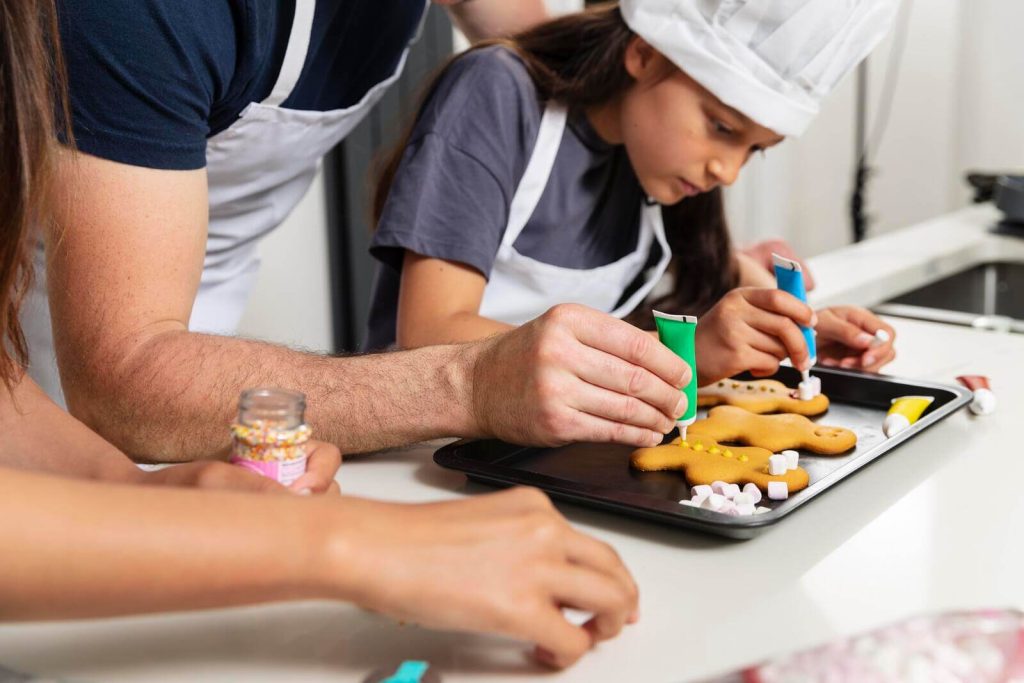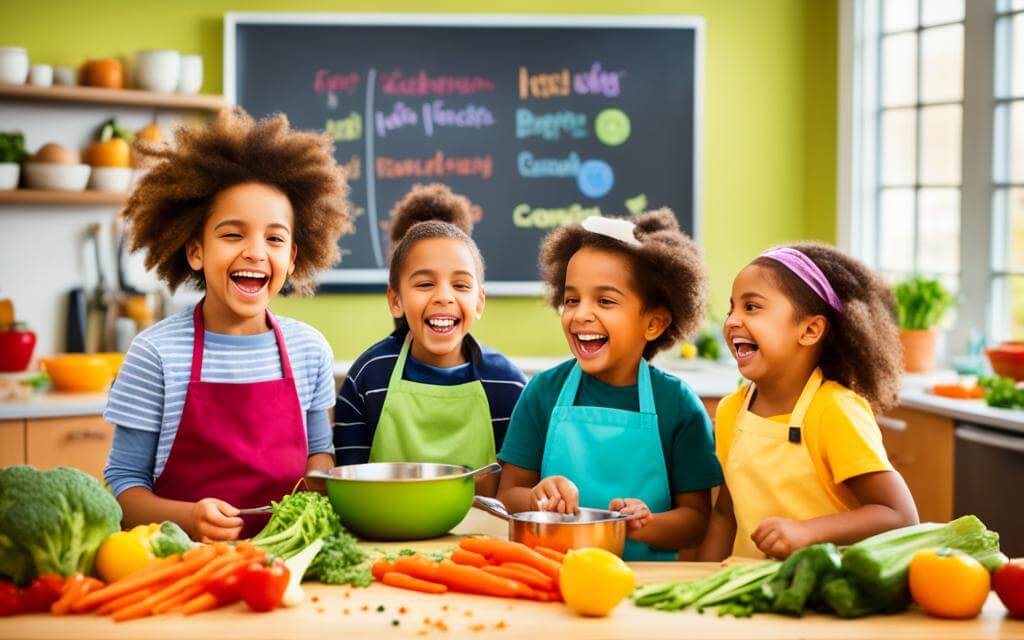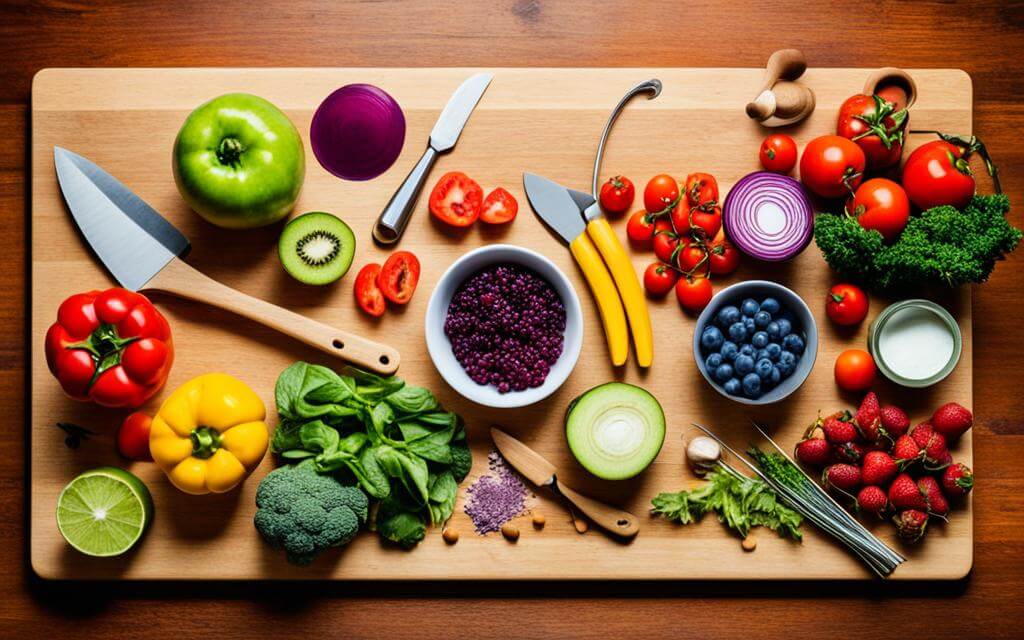News The Power of School Food Programs in Hamilton and...
Read MoreBlogs

“People who love to eat are always the best people,” said Julia Child. Culinary education in schools is powerful. It tackles childhood obesity and arms kids with life skills. They learn to make good choices about food for their whole lives.
The growing issue of childhood obesity is a big worry in Canada. Schools can be a key player by teaching kids to cook and be aware of what’s healthy. These efforts aren’t just about fighting obesity. They also help kids socially and emotionally. Plus, they learn valuable skills they’ll carry into adulthood.
By mixing cooking activities with nutrition lessons, schools make a big impact. Students learn to choose wisely about their diet. They also enjoy making meals that are good for them.

Key Takeaways
- Culinary education programs in schools can play a vital role in teaching children valuable cooking skills and promoting nutritional awareness.
- These programs not only aim to combat childhood obesity, but also provide social and emotional benefits for children.
- Integrating hands-on culinary activities and nutrition lessons can empower students to make informed choices about their diet and engage in the preparation of nutritious meals.
- Culinary education programs can help develop important life skills, such as numeracy, literacy, and problem-solving abilities.
- Leveraging community resources and partnerships can enhance the reach and impact of culinary education programs in schools.
The Importance of Culinary Education for Children
Overweight and obesity are common among kids in Europe. Luckily, culinary education is here to help. It teaches kids to choose healthier foods, cook nutritious meals, and keep up these good habits. By understanding the value of nutrition, children improve their health and well-being.
Combating Childhood Obesity and Promoting Healthy Habits
Culinary programs are key in fighting obesity and teaching kids to eat right. They offer cooking lessons and nutrition tips. This helps kids make smart food choices and build healthy eating habits that last.
Social and Emotional Benefits of Cooking for Children
Culinary lessons aren’t just about food; they support kids’ social growth too. Cooking helps children feel good about what they can make. It boosts their confidence and lets them work together. This teamwork teaches kids to communicate and develop strong social skills.
Developing Life Skills Through Culinary Activities
Young students gain important skills from cooking classes beyond just recipes. By measuring, reading recipes, and learning about food safety, kids build math and reading skills. These can help in school, at home, and prepare them for success in life.
Nutrition Education and Food Literacy
Food literacy is vital for young people to learn. It’s about more than just knowing how to cook. This knowledge helps kids understand how to choose, make, and check on the nutrition in foods. Incorporating food literacy into school programs helps kids see why nutrition is important for their health. They also learn how to pick the best foods for themselves.
Understanding the Concept of Food Literacy
Good school cooking classes put food literacy at their core. Kids learn a lot. They learn about where food comes from, what it has inside, and why it’s good. This deep knowledge helps them think about what they eat and make healthier meals.
Integrating Food Literacy into Culinary Education Programs
Studies show food literacy helps children eat better. They eat more fruits and veggies, less junk, and are open to new tastes. Teaching them the facts about food and how to cook healthy meals helps for life. It also helps fight against kids getting too heavy.

Hands-On Culinary Education Programs in Schools
In Canada, many schools and groups offer fun cooking lessons for kids. These programs teach through cooking, games, and tasting sessions. Kids get to learn how to cook and why nutrition is important. The way they’re taught can be different, but the goal is to make learning fun.
Overview of Existing Culinary Education Programs
The best cooking programs consider what kids need and where they come from. They use local foods and recipes, and things that fit the kids’ ages. This makes the class exciting and useful for every child. It helps kids learn in a happy, safe place.
Culturally-Relevant and Age-Appropriate Curriculum Design
In Canada, many schools and groups offer fun cooking lessons for kids. These programs teach through cooking, games, and tasting sessions. Kids get to learn how to cook and why nutrition is important. The way they’re taught can be different, but the goal is to make learning fun.
Evaluating the Effectiveness of Culinary Education Programs
Culinary education programs in schools really make a difference in what kids eat and like. Research shows students eat more fruits, veggies, and whole grains. They also become more open to trying new foods. These programs teach kids to love good-for-you foods by letting them cook and taste them.
Assessing Changes in Dietary Intake and Food Preferences
Experts look at how culinary programs change what kids eat and like. They find that these classes boost kids’ cooking knowledge and skills. This makes them more confident in the kitchen. Learning to cook helps kids eat healthier and enjoy good food throughout their lives.
Measuring Improvements in Culinary Skills and Self-Efficacy
Research also checks how well kids can cook and how they feel about it after these programs. They learn a lot and feel good about cooking. This boosts their belief in their cooking skills and makes them want to eat healthy. It sets them up to enjoy cooking for the rest of their lives.

school lunches
School lunches are important in what kids eat each day. They fill a big part of a child’s daily needs. Programs about cooking can help school lunches taste better. They teach kids to choose healthier meals, know the right amount to eat, and pick balanced foods. This way, kids learn to love good-for-you foods and can choose what’s best for them.
The Role of School Lunches in Children’s Nutrition
School lunches matter A LOT for kids. They give them the energy and nutrients they require to grow and learn. Making sure these meals are good for them helps their health, grades, and future.
Challenges and Opportunities in Improving School Lunch Quality
Schools find it tough to offer tasty, healthy lunches. Money and what kids like are big challenges. But, getting kids to help plan and cook meals can make a big difference. It makes them like the food more, even the good-for-you kind. Also, cooking classes can show schools how to use local, fresh, simple foods in the menu.
Integrating Culinary Education into School Lunch Programs
Adding cooking lessons to school lunches can make a winning combo. It means what kids cook and learn about in class shows up in their meals. This can mean cooking lessons at lunch, students picking what’s on the menu, and school meals that include dishes made by kids. This connects what they learn in class about healthy food with their actual meals, giving them good habits for life.
Engaging Parents and Communities
Cooking programs in schools aren’t just about the kids; they also reach out to parents. They offer families recipes, tips, and advice for a healthier lifestyle. Parents get to take part in cooking classes and receive materials to help at home.
Promoting Culinary Education at Home
Parents learn to cook healthy meals through these programs. They get to join workshops and receive guides on making nutritious and affordable food. Involving kids in cooking deepens family ties and teaches children to appreciate meals made with love.
Leveraging Community Resources and Partnerships
Culinary programs often team up with local experts to do more. Activities like chef demos, farm visits, and special classes are made possible. This way, schools offer a richer food education to kids with community support.
Policy and Advocacy Efforts
Policy and advocacy work is key for putting cooking classes in every school and keeping them there. It’s about making laws that say schools must teach cooking and good food. And it’s also about getting money for cooking tools, ingredients, and teachers. Those who want to make these changes happen can work locally, across states, or even nationwide. This way, all kids get to learn to cook well.
Supporting Culinary Education Through Legislation and Funding
Leaders and those who speak up for a cause need to make laws that make cooking and healthy eating part of what schools teach. This means schools must give kids chances to cook and learn about food. It also involves making sure schools have the money they need for these lessons. With enough support and funds from the government, schools can offer great cooking lessons for everyone.
Addressing Health Disparities and Access to Culinary Education
Learning to cook in school can help fix health problems some communities face. It can also make sure every kid can learn about good food, no matter where they come from. Efforts in policy and advocacy try to get rid of things like not being able to get to class or not having enough money. Everyone should have the chance to learn these important skills. Making sure these classes are easy to join helps everyone be healthier and more equal.
Conclusion
Teaching kids how to cook and about healthy food in schools can do a lot of good. It can help them be healthier, develop socially and emotionally, and live better lives. They learn cooking skills, become more aware of what’s nutritious, and form good eating habits.
This work is key in fighting childhood obesity and helping kids choose wisely about food for the long haul. With support from policies and communities, cooking education can change how kids see food and health. It can lead them to enjoy cooking, make smart choices, and be well-informed.
Adding culinary lessons to school programs is a big step in reducing child obesity and improving health. These classes give children the know-how and courage to deal with food and nutrition. In doing so, they can really influence the health of our society in the future.
FAQ
What is the role of culinary education programs in schools?
Culinary programs help students learn cooking skills and understand nutrition. They encourage kids to eat healthier to fight obesity. Besides teaching cooking, they offer lessons on life skills and bring social and emotional benefits.
How do culinary education programs address the issue of childhood obesity?
They teach kids to pick and cook healthy meals. By understanding nutrition, students are more likely to make better food choices. This aims to lower obesity rates in young people.
What are the social and emotional benefits of culinary education programs for children?
Hands-on cooking makes kids feel good about what they create and boosts their self-esteem. It’s not just about cooking; it’s about working together, talking, and building friendships. These social skills are important for kids as they grow.
How do culinary education programs help children develop practical life skills?
They teach children cooking basics, like measuring and safe food practices. These skills help in the kitchen and in other parts of life. Kids become more independent and ready for the future.
What is the concept of food literacy and how is it integrated into culinary education programs?
Food literacy is about knowing how to choose, cook, and see the health value of your food. Culinary programs teach kids these skills. This helps them understand the link between good food and health.
How do culinary education programs in schools address the quality and nutritional value of school lunches?
They make school lunches better by teaching kids what good meals look like. Students learn about balanced diets and portion control. This way, kids value healthy foods and make smarter food choices.
How do culinary education programs engage parents and the community?
By connecting with local chefs and nutrition experts, these programs offer kids and families better access to healthy eating info. They help parents continue healthy food habits at home. This community partnership is key to the program’s success.
What policy and advocacy efforts are important for the widespread implementation of culinary education programs in schools?
There needs to be support from laws and advocates to spread these cooking programs to more schools. Policies should promote cooking and nutrition in school lessons. Schools also need enough money for equipment and teachers.
Latest News
-
 The Power of School Food Programs in Hamilton and Peel24 Feb 2025
The Power of School Food Programs in Hamilton and Peel24 Feb 2025 -
 Battling Classroom Hunger: Ensuring Healthy Students for a Brighter Future23 Oct 2024
Battling Classroom Hunger: Ensuring Healthy Students for a Brighter Future23 Oct 2024 -
 Exciting News: Get Your School in the Game with Food For Good's Giveaway!31 Jan 2024
Exciting News: Get Your School in the Game with Food For Good's Giveaway!31 Jan 2024 -
 Food For Good Continues to Grow Beyond Borders Through McHugh Public School10 Jan 2024
Food For Good Continues to Grow Beyond Borders Through McHugh Public School10 Jan 2024 -
 Food For Good Presents Vision for a Healthier Ontario to Mississauga City Council10 Jan 2024
Food For Good Presents Vision for a Healthier Ontario to Mississauga City Council10 Jan 2024 -
 Kate Durdan and Heximer Seals 2nd Year with Food For Good08 Jan 2024
Kate Durdan and Heximer Seals 2nd Year with Food For Good08 Jan 2024 -
 Food For Good Embarks on New Horizons: Expanding Beyond Niagara Region08 Jan 2024
Food For Good Embarks on New Horizons: Expanding Beyond Niagara Region08 Jan 2024 -
 Wokbox and Food For Good: Nourishing Young Minds Together09 Sep 2023
Wokbox and Food For Good: Nourishing Young Minds Together09 Sep 2023 -
 Partnering for a Purpose: Twice the Deal and the Food For Good School Lunch Program09 Sep 2023
Partnering for a Purpose: Twice the Deal and the Food For Good School Lunch Program09 Sep 2023 -
 Partnering for a Brighter Future: Double Deals and the Food For Good School Lunch Program09 Sep 2023
Partnering for a Brighter Future: Double Deals and the Food For Good School Lunch Program09 Sep 2023
Recent Post
-
 The Power of School Food Programs in Hamilton and Peel24 Feb 2025
The Power of School Food Programs in Hamilton and Peel24 Feb 2025 -
 Battling Classroom Hunger: Ensuring Healthy Students for a Brighter Future23 Oct 2024
Battling Classroom Hunger: Ensuring Healthy Students for a Brighter Future23 Oct 2024 -
 Creative and Nutritious Drink Ideas for School Hot Meals26 Aug 2024
Creative and Nutritious Drink Ideas for School Hot Meals26 Aug 2024 -
 Nourishing Special Needs: A Guide to Personalized Nutrition11 Aug 2024
Nourishing Special Needs: A Guide to Personalized Nutrition11 Aug 2024 -
 18 Fun Hot Lunch Ideas for Kids28 Jul 2024
18 Fun Hot Lunch Ideas for Kids28 Jul 2024 -
 Best Meal Options for Special Diets27 Jul 2024
Best Meal Options for Special Diets27 Jul 2024 -
 Challenges and Opportunities of Providing Free School lunches27 Jul 2024
Challenges and Opportunities of Providing Free School lunches27 Jul 2024 -
 Back to School: What to pack for healthy school lunches?26 Jul 2024
Back to School: What to pack for healthy school lunches?26 Jul 2024 -
 Teaching Kids About Waste Management: A Guide for Parents and Educators21 Jul 2024
Teaching Kids About Waste Management: A Guide for Parents and Educators21 Jul 2024 -
 Free School Lunches: A Game Changer21 Jul 2024
Free School Lunches: A Game Changer21 Jul 2024
